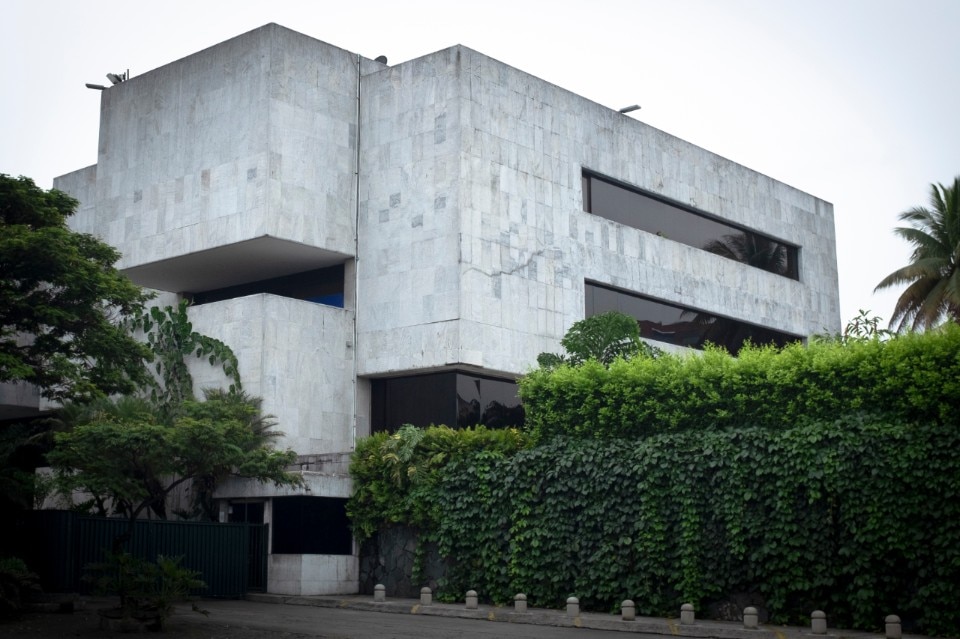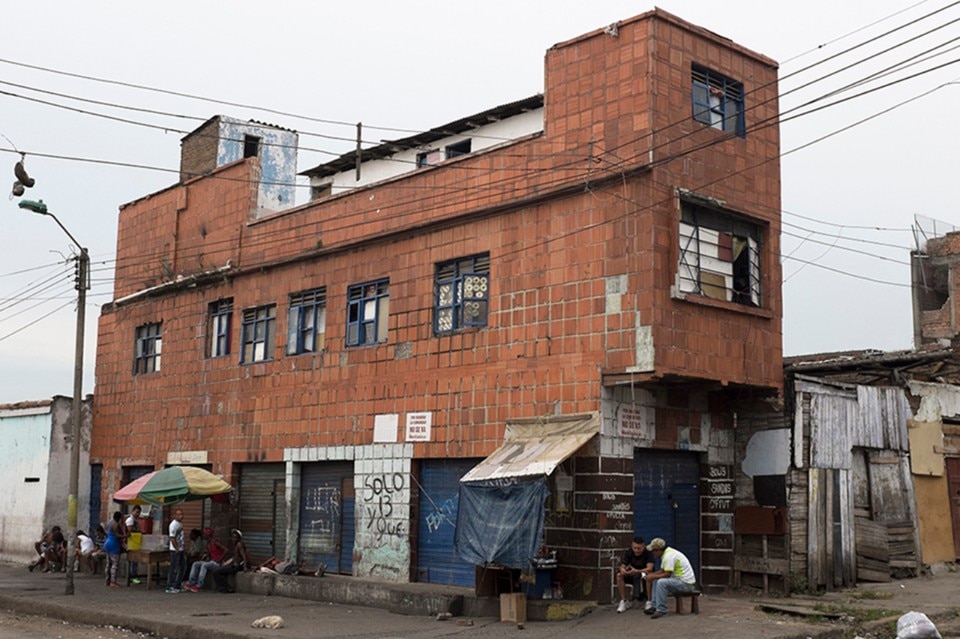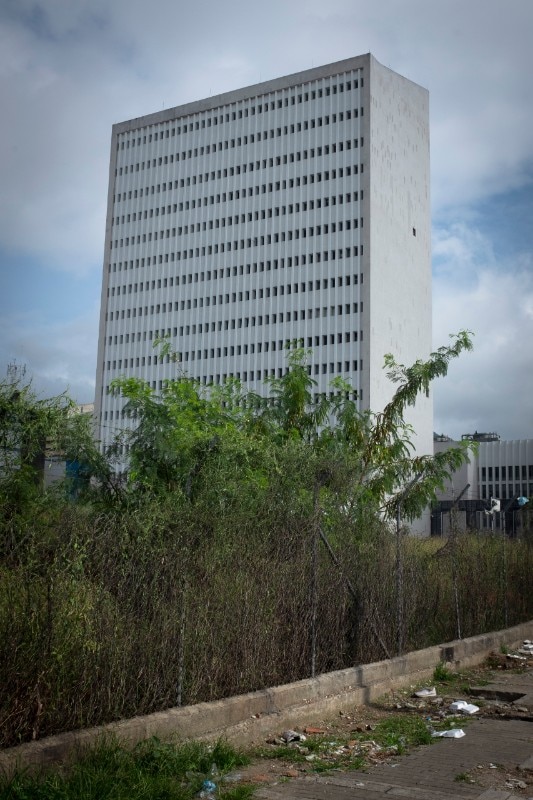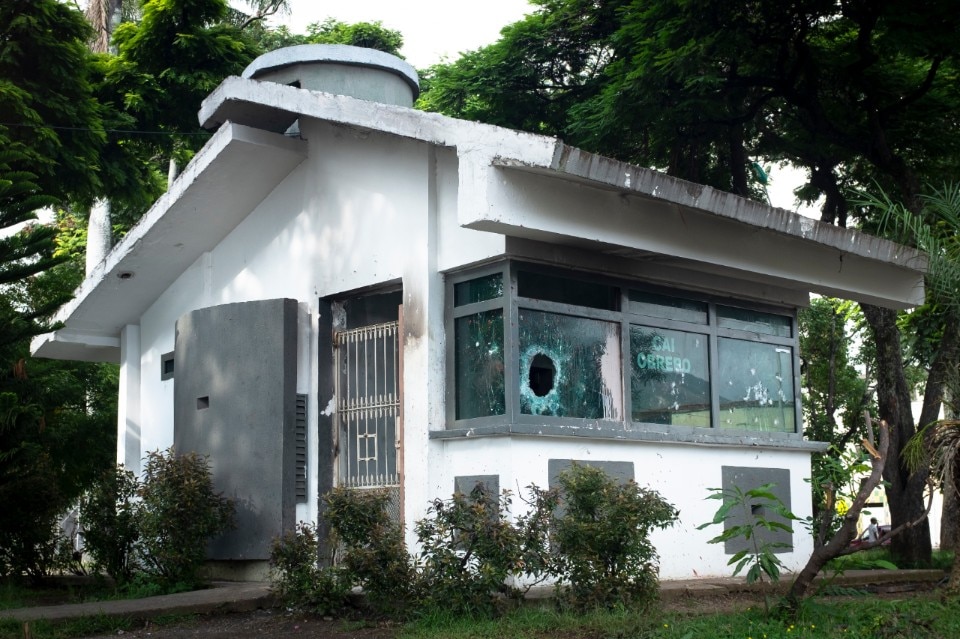In the 1970s, the southern part of Cali, Colombia, far from the urban blight of the overpopulated, congested, crime-ridden neighborhoods in the low rent areas of the city, became the most sought-after residential areas. The architecture in these exclusive neighborhoods, however, designed as defensive structures against the lower classes (electric fences, high gates and security outposts), is inevitably offensive. Offensive architecture became supercharged when billions of dollars of cocaine profits fell like snow upon the city. In the 80s, at the height of the Cali Cartel, the cocaine kings invaded the exclusive residential neighborhoods in the south of the city, buying up luxurious houses or constructing mansions next door. These constructions were notable for the quantity of classical columns, fabulous indoor and outdoor swimming pools, and imported marble floors, walls and ceilings, but also for the security structures inside and out.
Although the nouveau riche usually dump money into their homes to show off their newly acquired status, in Cali these luxury homes are mostly hidden behind high, fortified walls. Even the internal walls of the homes themselves are extra thick, allowing for hidden passageways and walk-in safes for storing gold, jewels, cash and cocaine (many of the workers hired to build these secret spaces were murdered to keep them secret). Investing immense sums of money in real estate and construction was not only a quick way to climb the social ladder, it was also the best way to launder illegal profits. Much of the money to be laundered was moved around the city by a fleet of armored vehicles owned by the Cali Cartel. More than just transporting dirty money, these nearly impenetrable bunkers on wheels were the perfect way to bring large consignments of cocaine and weapons in and out of the city, as well.

Despite being among the wealthiest inhabitants in the city and the owners of soccer teams, a bank, and a chain of drug stores, the capos of the Cali Cartel were nonetheless barred from entering the highest circle of caleño society, in particular, Club Colombia, an elite social club in the form of a giant concrete blockhouse which caters to the city’s crème de la crème. Founded in 1930 and inspired by the Jockey Club of Bogota, Club Colombia’s members come from the original European families of the city, including the owners of the sugar plantations and industry (the cartel of the other white powder) that still control most of Cali's formal economy and culture.
Stung by the rejection of high society, the Cali Cartel bosses went ahead and built an exact copy of Club Colombia, known as the Cali Cartel Bunker. Part of a large, fortified compound, the main building is a 50-meter-high bunker with bullet-proof windows, a heliport on its roof, an underground parking lot for twenty cars with secret tunnels, and ringed by a six-meter-high outer wall watched over by closedcircuit cameras. When the Cali Cartel was dismantled, their Bunker was confiscated by the government, and now houses an elite police squad.
Bunkers are an integral part of the urban landscape in Cali. Government administration buildings, court houses, prisons, police stations and military bases, which is to say, the whole social architecture of detention and incarceration in the city, are all fortified structures. Hidden behind high walls protected by turrets, camoflauged to blend in to the city’s sprawl, these cement blockhouses are brutal in aspect and function.
Indeed, of all architectural structures, urban bunkers are perhaps the ugliest, intentionally designed to strike terror in the hearts of citizens. This is especially true in Cali, where thousands of innocent people have been ‘disappeared’ into these structures, never to be seen again. Within Cali, there are two Palacios de Justicia where the government metes out punishment to the city’s criminals. The oldest and grandest, also known as the National Palace, a five-story construction designed in Louis 16th style in 1928 by a Belgian architect, with majestic balconies and bronze domes on the roof, is one of Cali’s most emblematic and elegant buildings. The Bunker de Justicia, a thirteen-floor concrete monolith built in the 1980s with tiny windows set into a cement blockhouse, resembles nothing so much as a prison.

This newer bunker of justice is located right in front of El Calvario, a traditional working-class neighborhood that due to government neglect became a major center for crime and drug distribution. Dealers of basuco, the cheapest and most addictive form of cocaine, took over one of the largest buildings and fortified it, sealing off the windows and doors and converting it into an inaccessible bunker. When El Calvario was completely razed in 2019 to make room for a future upscale mall and condos, the giant basuco bunker was the last building to be demolished, with the exception of a police station and a church, which both remain intact. In Colombia, “urban renewal” can be seen as the architectural equivalent of social cleansing in which whole working-class neighborhoods are ‘disappeared.’
Cali’s offensive architecture has met with strong criticism over the years. In 2007, the main police station in the center of the city was blown to bits by a car bomb, attributed to urban guerillas. Since then, a giant tank parked on the street leading into a police station in the center of the city has become part of the city’s anti-antiarchitecture. In 2008, the Bunker de Justicia was rocked by a car bomb, also attributed to guerillas.

During the national strike protests this year, several of the most brutal and Brutalist government buildings were attacked and many police stations were vandalized. In retaliation, police in Cali created ad hoc spaces in which to corral hundreds of people rounded up during peaceful protests, including an upscale mall in which a parking lot was used as a detention and torture chamber. Malls, in general, can be considered fortified outposts of the US’s post-colonial economy, which is why many malls were vandalized during the protests. More than mere criticism, the vandalism of government buildings and malls in Cali, especially during the national strike, are protests against the social and economic inequalities, corruption and state-sponsored violence that takes place within these bunkers.
Opening image: a police bunker in Cali.


